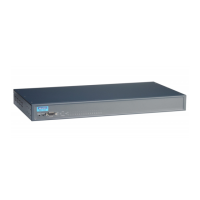
Do you have a question about the Advantech EKI-1526 and is the answer not in the manual?
| Operating Temperature | -10°C to 60°C (14°F to 140°F) |
|---|---|
| Power Input | 12 to 48 VDC |
| Mounting | DIN-rail |
| Certifications | CE, FCC, UL |
| Product Type | Ethernet Switch |
Lists the technical specifications, including interface, physical, environment, and power details.
Provides a detailed look at the physical components of the EKI-1526/1528 series devices.
Guides on physically connecting the device to power, network, and serial devices.
Instructions for installing the device using rack mount brackets.
Details the pin assignments for the DB9 serial connectors.
Provides instructions for connecting AC or DC power to the device.
Step-by-step guide for installing the Advantech EKI Device Configuration Utility.
Configures general settings for the main form, including window behavior and language.
Explains how to automatically search for and discover connected EKI serial device servers.
Guides on configuring the device's IP address, subnet mask, and gateway.
Covers administrative functions for securing and managing the device server.
Describes how to locate a specific serial device server on the network.
Explains how to lock and unlock the device server for enhanced security.
Guides on resetting the device server to its original factory default configuration.
Explains how to reset the device server and save configuration settings.
Provides instructions on how to update the device's firmware.
Explains how to create and manage virtual COM ports for application compatibility.
Covers data transfer modes using TCP and UDP protocols.
Details the operation of the device server as a TCP client.
Details the operation of the device server as a TCP server.
Explains the Control mode for modem-like AT command operation.
Explains how the COM port mapping software creates virtual COM ports.
Guides on mapping physical serial ports to virtual COM ports on the PC.
Configures the network settings for the device's Ethernet ports.
Allows configuration of serial port parameters.
Guides on establishing and using a Telnet connection to the device.
Guides on establishing a serial connection to the device's console port.